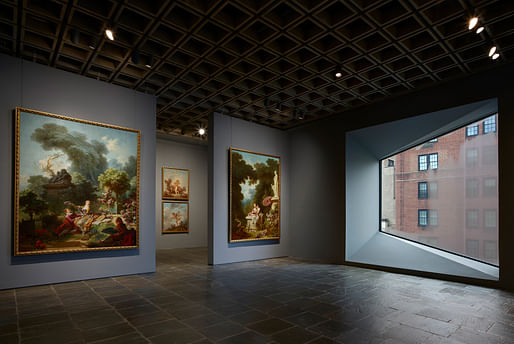

While the Frick Collection's Gilded Age mansion in Manhattan undergoes a $160-million expansion and renovation project led by Selldorf Architects with Executive Architect Beyer Blinder Belle, highlights of the substantial art collection have found a temporary new home for the next two years inside Marcel Breuer's iconic Brutalist building on Madison Avenue.
The selection of works shown, and freshly juxtaposed within its unexpected new setting at Frick Madison, includes treasured paintings and sculptures by Bellini, Clodion, Gainsborough, Goya, Holbein, Houdon, Ingres, Piero della Francesca, Rembrandt, Titian, Turner, Velázquez, Vermeer, Whistler, and many others.
"The Frick has created a sequence of gallery spaces at Frick Madison that reflects the museum’s traditional emphasis on intimate encounters with both art and architecture and allows direct access to objects without the interference of vitrines or stanchions," reads the Frick's statement on its March 18 opening.
"Recognizing that Marcel Breuer’s stark creation of stone and concrete provides a very different museum experience than that offered by the Frick’s Beaux Arts mansion, the curatorial team has embraced this modernist setting as a unique opportunity."
"Rather than attempting to replicate the mansion’s domestic display, the installation respects the forms and materials Breuer used, juxtaposing beloved Frick masterpieces with the building’s distinct architectural features, such as its signature trapezoid windows."
7 Comments
What a curious juxtaposition to see Renaissance, Rocco, Neoclassical, and impressionism in the old Whitney / Met Breuer building. Contrast can be interesting and... I mean, the Frick collection looks great on it's own merits but ... this just doesn't do it for me.
Fantastic juxtaposition of classical and modern makes them both sing!
Everything looks good when displayed in a building like this, even boring old classical paintings(!)
Even dumpy old modernism looks good when exhibiting classical paintings...viva eclecticism!
i really loved the met version.. it was one of my favorite places in the city. judging from the photographs, my feeling is this can't live up to it, but will have to visit in person.
The Whitney was designed for art—any art. The interior space is flexible, intimate, and accessible, and understated to emphasize what matters, what is on display.
Putting the Bellini St. Francis before the trapezoid window is maybe a bit gimmicky, but it makes me smile, glow even. There's a long dialogue (western) with past and present, much back and forth—and with whatever else lies beyond (or doesn't).
The large window sign doesn't serve the building or the collection. I assume it is temporary.
The space would also work well with Asian art. Imagine if the St. Francis—photo above—were replaced with:
Lit by the trapezoid window.
Block this user
Are you sure you want to block this user and hide all related comments throughout the site?
Archinect
This is your first comment on Archinect. Your comment will be visible once approved.